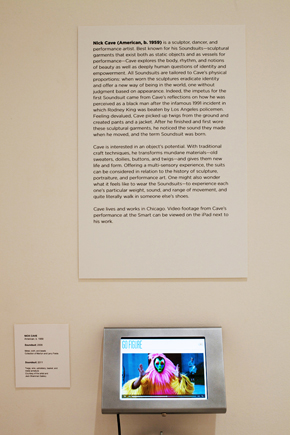Watching and Learning: When New Technologies Enhance the Museum Experience
 By Diego Arispe-Bazan
By Diego Arispe-BazanMA'11 University of Chicago and Smart curatorial intern
As high-tech tools become more accessible and essential in every day life, rhapsodized about by tech-savvy urbanites and digital age apologists, the debate over their relevance has become a hot topic among museum administrators, curators, and programmers. A large component of my job as a curatorial intern at the Smart this summer involved evaluating visitor engagement with the artist videos that accompanied the Go Figure exhibition, so as to inform the development of interpretive media for Feast.
The Education Department was planning to conduct surveys regarding visitor perspectives on the exhibition, so I asked them to include a few questions about the videos, which showcased artists discussing the particulars of their work in short, conversational interviews. But I also decided to work undercover. In addition to the quantitative data docents could collect via survey, I added a qualitative, observational research component. I spent time in the gallery each day. I took notes in my own handy gadget (an old, Generation 1 iPod), recording the demeanor, body language, and trajectory of visitors within the gallery. I listened, and occasionally elicited statements regarding the videos as if I were merely an inquisitive visitor. While varying from individual to individual, general gestural and verbal cues are similar across the board. I also enlisted the aid of the gallery attendants after several of them, upon hearing about my project, enthusiastically volunteered their own observations of visitor movement through the gallery.
The debate on interpretive technologies was lively among the Smart interns. It centered on the issue of how multiplicity in experience could be flattened out. The argument is not without basis: interpretive technology, used indiscriminately, can turn a gallery into an arcade. In fact, certain visitors who shared this view eschewed the iPads entirely. However, through my observation and the comments gathered from the museum guards, it became clear that those who chose to pick up the iPads were eager to embrace the integration of interactive digital media into the gallery experience. The only negative comment was that the volume was sometimes too loud.
Ultimately, as innovative curators and researchers such as Nina Simon and Dana Carlisle Kletchka have explained, the inclusion of interactive media in the museum should not be viewed as an impending inevitability, but an opportunity to connect with visitors and enthusiasts. Far from oppressively didactic, the videos in Go Figure offered visitors an expanded understanding of the process behind the composition of each piece, and some of the theoretical entanglements that inspired them. Since many of the pieces to be included in the Feast exhibition are performative, or showcase objects employed in past performances--whether they are instruments or detritus--the interpretive media to be included should definitely continue in this vein. Because our goal is to enrich individual engagement with artists and their work, these enhancements seem to make sense.
Photo by Joseph Rynkiewicz